- Subscribe to RSS Feed
- Mark Topic as New
- Mark Topic as Read
- Float this Topic for Current User
- Bookmark
- Subscribe
- Mute
- Printer Friendly Page
Working with dB (decibels)
- Mark as New
- Bookmark
- Subscribe
- Mute
- Subscribe to RSS Feed
- Permalink
- Notify Moderator
Working with dB (decibels)
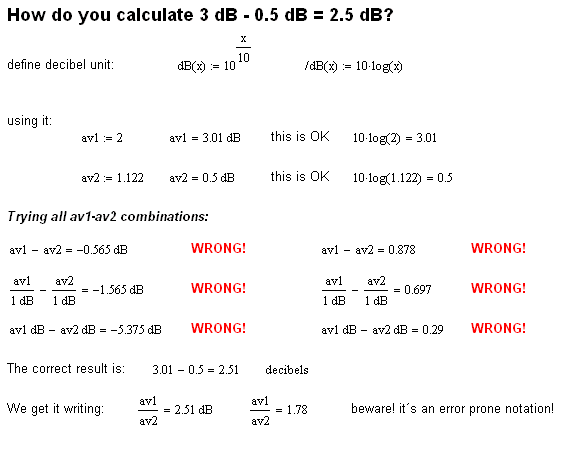
entering av1 and av2 in dB makes no diference:
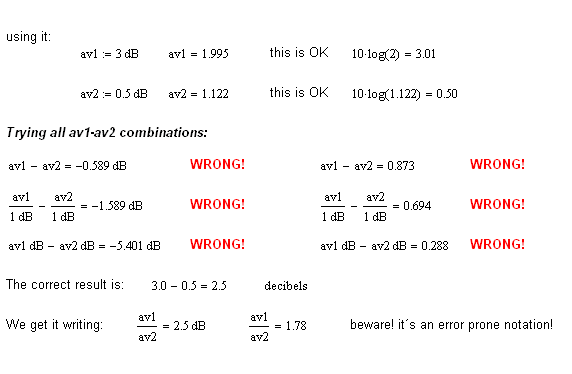
Any tip to avoid pitfalls using dB?.
Solved! Go to Solution.
Accepted Solutions
- Mark as New
- Bookmark
- Subscribe
- Mute
- Subscribe to RSS Feed
- Permalink
- Notify Moderator
Axel Harris wrote:
How do you hide brackets sorrounding N1?
I use the prefix operator:
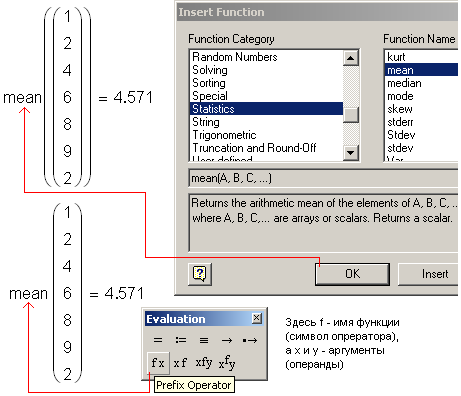
- Mark as New
- Bookmark
- Subscribe
- Mute
- Subscribe to RSS Feed
- Permalink
- Notify Moderator
0+0=0
but 0dB+0dB is not equal 0dB
See the picture please
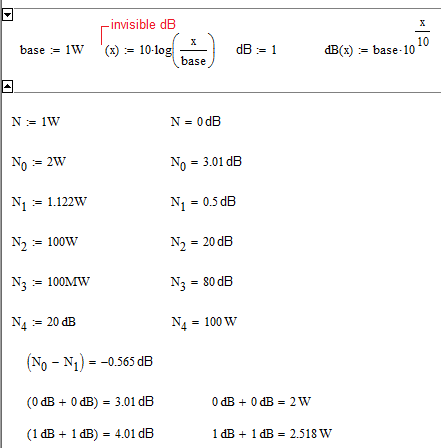
- Mark as New
- Bookmark
- Subscribe
- Mute
- Subscribe to RSS Feed
- Permalink
- Notify Moderator

I colorized for clarity.
How do you hide brackets sorrounding N1?
- Mark as New
- Bookmark
- Subscribe
- Mute
- Subscribe to RSS Feed
- Permalink
- Notify Moderator
Axel Harris wrote:
How do you hide brackets sorrounding N1?
I use the prefix operator:

- Mark as New
- Bookmark
- Subscribe
- Mute
- Subscribe to RSS Feed
- Permalink
- Notify Moderator
it worked!
you are a very master.
Thanks a lot
Nevertheless I managed to work this way it's a lot of work to change styles.
I thik it's easier to me to write
dB := 1 (dummy unit)
dB(x):=10*log(x) dB definition
using it:
a := 5 (times)
A := dB(5) = 6.989 dB
- Mark as New
- Bookmark
- Subscribe
- Mute
- Subscribe to RSS Feed
- Permalink
- Notify Moderator
Valery Ochkov wrote:
0+0=0
but 0dB+0dB is not equal 0dB
See the picture please
Is that right, Valery? It's a long time since I played with decibels with any degree of seriousness, but I thought that 0 dB + 0 dB does = 0 dB? What you appear to be doing is adding powers (W) and then treating their decibel equivalents as linearly scaled values (in a similar way to defining lengths in metres and then adding their feet equivalents). However, decibels are logarithmic quantities and, IIRC, adding them is equivalent to multiplying the underlying powers (ie, gain) not adding them, with 0 dB being the equivalent of multiplying by one?
Am I getting the wrong end of the stick here?
Stuart
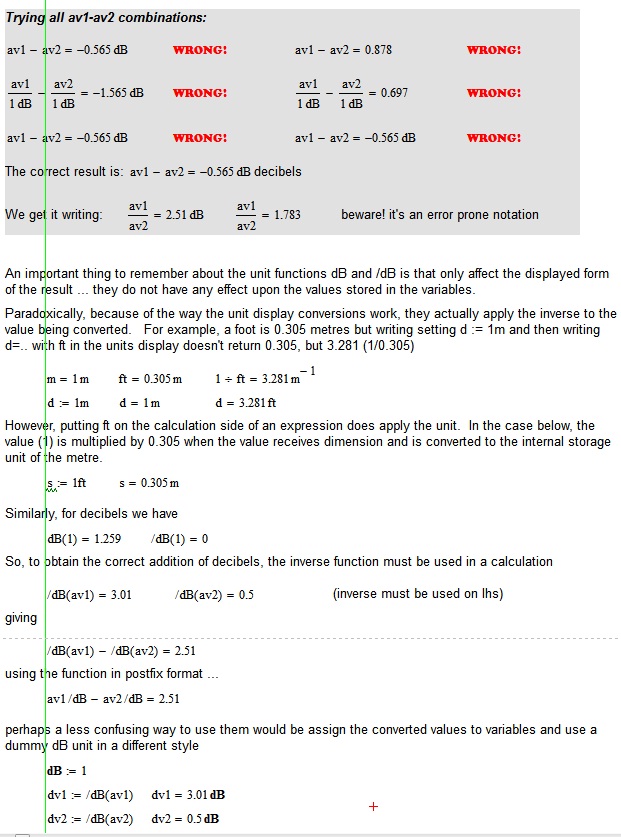
- Mark as New
- Bookmark
- Subscribe
- Mute
- Subscribe to RSS Feed
- Permalink
- Notify Moderator
Stuart_Bruff wrote:
Valery Ochkov wrote:
0+0=0
but 0dB+0dB is not equal 0dB
Is that right, Valery?
See the picture:
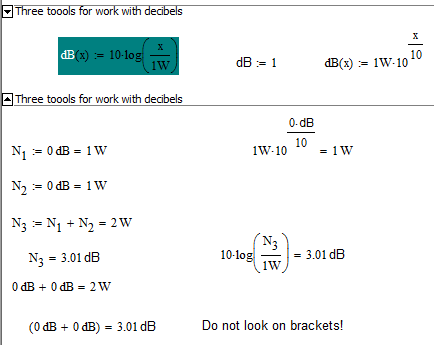
- Mark as New
- Bookmark
- Subscribe
- Mute
- Subscribe to RSS Feed
- Permalink
- Notify Moderator
They are not wrong, although they are not necessarily correct either. There is not one way to add values expressed in dB, there are two. And the root of your problem is that you are not distinguishing a dB that represents power (e.g. dBm) and a dB that represents gain. They are not the same thing, and cannot be handled the same way.
- Mark as New
- Bookmark
- Subscribe
- Mute
- Subscribe to RSS Feed
- Permalink
- Notify Moderator
"Everything you ever wanted to know about decibels but were afarid to ask..."
Here is a good reference on dB & dBm:
- Mark as New
- Bookmark
- Subscribe
- Mute
- Subscribe to RSS Feed
- Permalink
- Notify Moderator
Mathcad is or was selled like a sheet of paper which makes the number crunching for you. This means: you write your formulas and equiationes as usual and MathCad makes the calculations for you. Well. But just when we work with dB such approach is no longer true. Intuition is not longer valid and what MathCad does is obscure and counterintuitive
As a matter of example: 0 dB + 0 dB = 0 dB in real paper but is 3.01 dB in MathCad "paper" Ochkov version (i.e using postfix operator)
Of course if you write 10*log(1)+10*log(1) on real paper or in MathCad paper you get 0 not 3.01
- Mark as New
- Bookmark
- Subscribe
- Mute
- Subscribe to RSS Feed
- Permalink
- Notify Moderator
Intuition is not longer valid and what MathCad does is obscure and counterintuitive
As a matter of example: 0 dB + 0 dB = 0 dB in real paper but is 3.01 dB in MathCad "paper" Ochkov version (i.e using postfix operator)
No, sorry, but you are wrong. If the dB values represent gain or attenuation then 0 dB + 0 dB = 0 dB. But if the dB values represent two uncorrelated powers, for example sound levels, then 0 dB + 0 dB = 3.01 dB. Mathcad calculates the second answer because of the way the values are stored internally. There are two possible ways to add values expressed in dB, depending no what they represent, so the only solution that can always be correct involves two summation (and two subtraction) operators, and an understanding of dB (for which read the excellent reference Norm pointed us to).
- Mark as New
- Bookmark
- Subscribe
- Mute
- Subscribe to RSS Feed
- Permalink
- Notify Moderator
- Mark as New
- Bookmark
- Subscribe
- Mute
- Subscribe to RSS Feed
- Permalink
- Notify Moderator
Richard Jackson escribió:
Intuition is not longer valid and what MathCad does is obscure and counterintuitive
As a matter of example: 0 dB + 0 dB = 0 dB in real paper but is 3.01 dB in MathCad "paper" Ochkov version (i.e using postfix operator)
No, sorry, but you are wrong. If the dB values represent gain or attenuation then 0 dB + 0 dB = 0 dB. But if the dB values represent two uncorrelated powers, for example sound levels, then 0 dB + 0 dB = 3.01 dB.
dB is 10*log(ratio) if you talk about energy expresed in lograitmic units you must not name those units dB. What electrical enginners do is to talk about dBm (reference 1 mW, so dBm = 10 log (P/mW)) and electoacustic people talks about dB of SPL when reference is certain pressure.
- Mark as New
- Bookmark
- Subscribe
- Mute
- Subscribe to RSS Feed
- Permalink
- Notify Moderator
dB is 10*log(ratio) if you talk about energy expresed in lograitmic units you must not name those units dB.
I agree. But people do (especially when talking about sound levels).
The fact is though, that if we take dB to always mean gain or attenuation then mathematically 0 dB + 0 dB = 0 dB is not correct. When you do this on paper you are actually first removing the units to get only the numerical values, then adding the numerical values, and then putting the units back again. That is not how the normal addition operator works, so you have to define a new operator that does this. In the worksheet I posted I could have defined the operators exactly that way, but since dB is a logarithmic scale it was easier just to define them as ratios.
- Mark as New
- Bookmark
- Subscribe
- Mute
- Subscribe to RSS Feed
- Permalink
- Notify Moderator
GREAT file. Everyone suffering with dB should download ir
- Mark as New
- Bookmark
- Subscribe
- Mute
- Subscribe to RSS Feed
- Permalink
- Notify Moderator
Actually, Tom Gutman had assisted me in creating a unit definition with the postfix operator a while ago. It is not obvious, but I was working with sound. I believe the thread is this one http://communities.ptc.com/message/133884
- Mark as New
- Bookmark
- Subscribe
- Mute
- Subscribe to RSS Feed
- Permalink
- Notify Moderator
The unit definition for dB is in the tutorials. What the tutorial does not address is the fact that dB can be used to represent either a power or a gain, and dB cannot be handled the same way for both.
- Mark as New
- Bookmark
- Subscribe
- Mute
- Subscribe to RSS Feed
- Permalink
- Notify Moderator
Richard,
dB is dB. In otherwords, "Decibels are not a proper unit. It is a scale." http://communities.ptc.com/message/60520#60520 In my sound calculations, I calculate for both sound pressure (L.p) and sound power (L.w) and differentiated that way. The scale of dB remains, it's how you calculate either the pressure (gain?) or power. Sorry, not as familiar on how it's used in electrical calculations. In my work, I defined dB, when I "adjusted" the scale to dB(A), I defined dB=dB(A) and explained right before the math. This allowed me to trace the reason for the "scale" redefinition, keep the correct scale, and continue to make the print out look like my hand calculations. It was quite the learning experience.
BTW, where is Tom?
- Mark as New
- Bookmark
- Subscribe
- Mute
- Subscribe to RSS Feed
- Permalink
- Notify Moderator
dB can represent a power, or a pressure. But it can also represent a gain, i.e. an amplification factor. You can't handle that the same way. Read the wworksheet I posted, and the reference Norm pointed out in his post.
Tom didn't like the new forums, and disappeared.
- Mark as New
- Bookmark
- Subscribe
- Mute
- Subscribe to RSS Feed
- Permalink
- Notify Moderator
Richard,
I agree with what you are saying and you have helped me more times than I care to count ![]() . Moreover, when I've used dB, in any calculation, I was taught a similar way to
. Moreover, when I've used dB, in any calculation, I was taught a similar way to
Norm Schutzkus wrote:
Bottom of pg 4 and top of pg 5 where the paper discusses the IEC 27 standard where levels are to be indicated with "L".
In my case, I use L.p (pressure) or L.w (power) and adjust the "unit" scale after the math ... where dB=dB(A) therefore L.p=???dB(A). This allows me to keep the math and scale consistent, yet the output scale is as expected on paper dB(A). Also, the "voltage" power decibel is the same as sound pressure for which I am accustomed to working in ![]()
Also, by using the levels as "L", I can diferentiate between dBA (dB Amps) vs. dB(A) (dB with an A-weight scale)
- Mark as New
- Bookmark
- Subscribe
- Mute
- Subscribe to RSS Feed
- Permalink
- Notify Moderator
I do not lke that way of doing it. The unit on the right is always dB, even though not all dB are referenced to the same value (or, in the case of a gain, to any specific value at all). It then relies on the variable name on the left to indicate what that particular dB actually is. I don't even like that way of doing it on paper. What are you supposed to do if you want two different variables defined, but IEC 27 says they should be be called LP/1mW? I'm not familiar with IEC 27 though, so maybe I just miosunderstand their naming scheme. Regardless of that issue though, in Mathcad their scheme also means you lose one of Mathcad's great benefits: unit checking.
Actually, in Tom's worksheet (http://communities.ptc.com/servlet/JiveServlet/download/133885-15301/xx(165).xmcdz) in the first thread you referenced Tom also defines two diffferent dB units, one of which is a gain, and shows they can't be added. He solves it by multiplying instead. That works, but IMHO doesn't look as nice as when a extra "addition" operator (that is really a multiplication!) is used. I'm biased though, because that's in my worksheet ![]()
- Mark as New
- Bookmark
- Subscribe
- Mute
- Subscribe to RSS Feed
- Permalink
- Notify Moderator
BTW, the postix operator does not work in Prime 2.0 at all and does not seem planned any time in the very near future!
- Mark as New
- Bookmark
- Subscribe
- Mute
- Subscribe to RSS Feed
- Permalink
- Notify Moderator
Rick,
This is one of the many reasons my company has not converted ... sheets using functions features that are not yet supported in Prime ![]()
- Mark as New
- Bookmark
- Subscribe
- Mute
- Subscribe to RSS Feed
- Permalink
- Notify Moderator
Rick Mason wrote:
BTW, the postix operator does not work in Prime 2.0 at all and does not seem planned any time in the very near future!
Yes, the postix operator does not work in Prime 2.0![]()
See the item #5 in this poll





